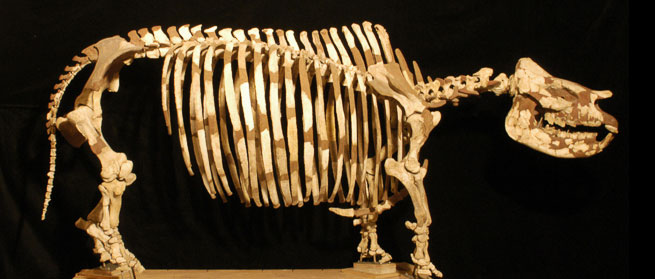

Mixon-Mixson Genealogy
The Mixson's Bone Bed

A composite skeleton of Teleoceras proterum on display at the Florida Museum
of Natural History.
J. J. Mixson of south Archer
Florida has a very interesting hill of prehistoric animal remains for the
geologist to look after. Dr. J. C Neal formerly of Archer, now of Lake
City, frequently examined them, both scientifically and curiously; sending a
numerous specimens to the Smithsonian Institute, but it remains for the
geologists to determine their full character and value.
The Morning News, Savannah GA, March 1, 1890
In 1884 James Joyce Mixson#735 found an interesting bone on his plantation which appeared to be very old. James then contacted Dr. John C. Neal who upon further excavation found many fossilized bones who sent the fossils to the Smithsonian in Washington DC which then forward them to Leidy for further study. Recognizing their significance, Leidy requested that the United State Geological Survey investigate the site which they did so in 1884-1885. All of the specimens from this first excavation phase are housed at the Smithsonian Institution’s National Museum of Natural History in Washington, DC. A second major excavation was done in the late 1930’s and 1940’s which were transferred to the American Museum of Natural History in New York and made available for study.
The fossils were determined to be from the late Miocene Epoch; early Hemphillian (Hemphillian 1) land mammal age, about 8 to 9 million years old (estimated). Leidy named nine new species based on fossils from Mixson’s Bone Bed, two rhinoceroses, two hipparion horses, three camelids, one gomphothere proboscidian, and one suid. The latter he quickly realized was an error and was in fact the lower tusk-like incisor of a rhino. Of these, six are still regarded as valid species. See more at The Florida Museum, Mixson’s Bone Bed
Updated 09.14.2021
Page 110